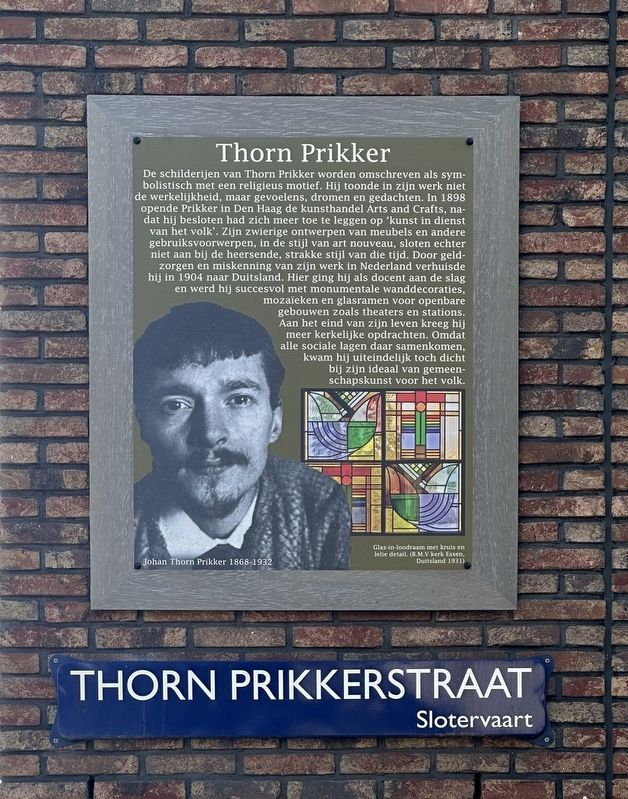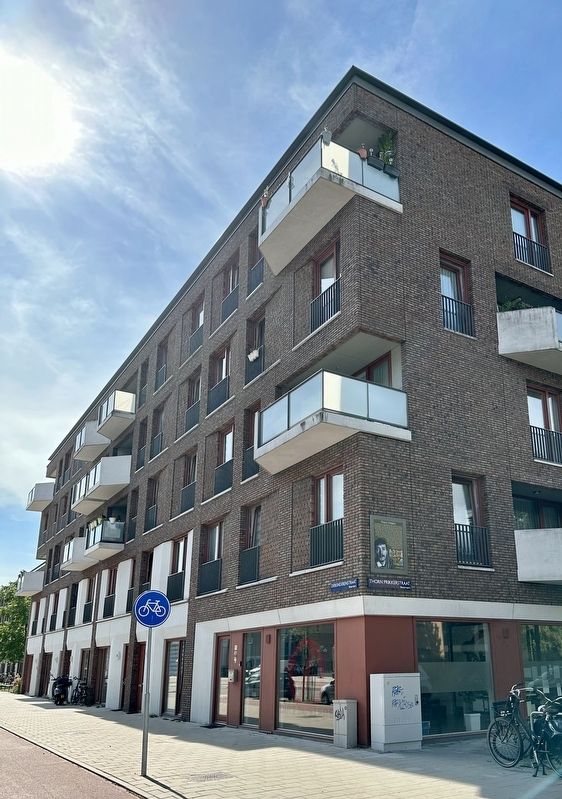Amsterdam Nieuw-West , North Holland, Netherlands — Northwestern Europe
Thorn Prikker
De schilderijen van Thorn Prikker worden omschreven als symbolistisch met een religieus motief. Hij toonde in zijn werk niet de werkelijkheid, maar gevoelens, dromen en gedachten. In 1898 opende Prikker in Den Haag de kunsthandel Arts and Crafts, nadat hij besloten had zich meer toe te leggen op 'kunst in dienst van het volk'. Zijn zwierige ontwerpen van meubels en andere gebruiksvoorwerpen, in de stijl van art nouveau, sloten echter niet aan bij de heersende, strakke stijl van die tijd. Door geldzorgen en miskenning van zijn werk in Nederland verhuisde hij in 1904 naar Duitsland. Hier ging hij als docent aan de slag en werd hij succesvol met monumentale wanddecoraties, mozaïeken en glasramen voor openbare gebouwen zoals theaters en stations. Aan het eind van zijn leven kreeg hij meer kerkelijke opdrachten. Omdat alle sociale lagen daar samenkomen, kwam hij uiteindelijk toch dicht bij zijn ideaal van gemeenschapskunst voor het volk.
Thorn Prikker's paintings are described as symbolist with a religious motif. In his work he did not show reality, but rather feelings, dreams and thoughts. In 1898, Prikker opened the art dealership “Arts and Crafts” in The Hague, after he had decided to focus more on 'art in the service of the people'. However, his elegant designs of furniture and other utensils, in the style of Art Nouveau, did not fit in with the prevailing, austere style of the time. Due to financial worries and lack of recognition of his work in the Netherlands, he moved to Germany in 1904. There he started working as a teacher and became successful with monumental wall decorations, mosaics and stained glass windows for public buildings such as theaters and train stations. Towards the end of his life he received more church assignments. Because all social strata come together there, one could say that he ultimately came close to his ideal of community art for the people.
Erected 2023 by Geef Straten Een Gezicht.
Topics and series. This historical marker is listed in this topic list: Arts, Letters, Music. In addition, it is included in the Give Streets a Face / Geef Straten Een Gezicht series list. A significant historical year for this entry is 1898.
Location. 52° 21.722′ N, 4° 50.416′ E. Marker is in Amsterdam, Noord-Holland (North Holland). It is in Amsterdam Nieuw-West. Marker is at the intersection of Thorn Prikkerstraat and Derkinderenstraat, on the right when traveling east on Thorn Prikkerstraat. Touch for map. Marker is at or near this postal address: Thorn Prikkerstraat 1, Amsterdam, Noord-Holland 1062 BX, Netherlands. Touch for directions.
Other nearby markers. At least 8 other markers are within walking distance of this marker. Anton Waldorp (within shouting distance of this marker); Antoon Derkinderen (within shouting distance of this marker); Chris Lebeau (about 120 meters away, measured in a direct line); Louise Marie Loeber (about 150 meters away); Marius Bauer (about 150 meters away); Charles Leickert (about 180 meters away); Jan Sluijters (about 210 meters away); August Allebé (about 240 meters away). Touch for a list and map of all markers in Amsterdam.
Also see . . . Johan Thorn Prikker (Wikipedia).
Overview: Johan Thorn Prikker (6 June 1868, The Hague - 5 March 1932, Cologne) was a Dutch artist who worked in Germany after 1904. His activities were very eclectic, including architecture, lithography, furniture, stained-glass windows, mosaics, tapestries and book covers as well as painting. He also worked in a variety of styles; such as Symbolism, Impressionism and Art Nouveau.(Submitted on September 20, 2023.)
Credits. This page was last revised on December 31, 2023. It was originally submitted on September 19, 2023, by Andrew Ruppenstein of Lamorinda, California. This page has been viewed 38 times since then and 7 times this year. Photos: 1, 2. submitted on September 19, 2023, by Andrew Ruppenstein of Lamorinda, California.

